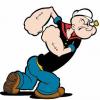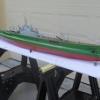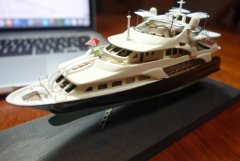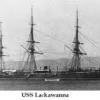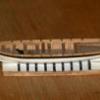MORE HANDBOOKS ARE ON THEIR WAY! We will let you know when they get here.
×
-
Posts
1,735 -
Joined
-
Last visited
Reputation Activity
-
 flying_dutchman2 got a reaction from Keith Black in SPERWER by KORTES - FINISHED - 1:30 scale - Friescheboeier Yacht
flying_dutchman2 got a reaction from Keith Black in SPERWER by KORTES - FINISHED - 1:30 scale - Friescheboeier Yacht
The deck is beautifully done and the pins in the deck as well. I like how you made the curved baton for the bow. I am assuming that it was a difficult job.
I love all the curves from Dutch ships. It's what makes them unique.
Marcus
-
 flying_dutchman2 got a reaction from popeye the sailor in Smit Rotterdam by Sjors - Billing Boats - 1:75 - Sea tug
flying_dutchman2 got a reaction from popeye the sailor in Smit Rotterdam by Sjors - Billing Boats - 1:75 - Sea tug
She is starting to look great. Nice sanding job.
Marcus
-
 flying_dutchman2 got a reaction from popeye the sailor in Genesis by Omega1234 - FINISHED - 1/300 - 49 m Mega Yacht
flying_dutchman2 got a reaction from popeye the sailor in Genesis by Omega1234 - FINISHED - 1/300 - 49 m Mega Yacht
By holding the 4 chairs with your fingers, one can truly see how small and detailed everything is.
Excellent craftsmanship
Marcus
-
 flying_dutchman2 got a reaction from Piet in Boyer by flying_dutchman2 - FINISHED - Scale 1:48 - 17th Century Dutch Coastal water freighter by Marc Meijer
flying_dutchman2 got a reaction from Piet in Boyer by flying_dutchman2 - FINISHED - Scale 1:48 - 17th Century Dutch Coastal water freighter by Marc Meijer
Thanks Pattick.
Marcus
-
 flying_dutchman2 got a reaction from Piet in Boyer by flying_dutchman2 - FINISHED - Scale 1:48 - 17th Century Dutch Coastal water freighter by Marc Meijer
flying_dutchman2 got a reaction from Piet in Boyer by flying_dutchman2 - FINISHED - Scale 1:48 - 17th Century Dutch Coastal water freighter by Marc Meijer
Have been spending several weeks making different types of blocks. Very time consuming assembly work. Several hours everyday.
After looking at prices of the different types of blocks I need for the Boyer, it made sense to me to make them myself and save some money. Compared to what is on the market, my blocks are not as nice looking...... Yet. But with time, they will become better looking.
Once I start building a Fluit and a war yacht I may just cave and purchase the blocks as I need lots of them.
Tried out different type of stock to see for myself what works. Walnut (easy, sands well, will use this for the Boyer), cherry (breaks easily), pear (sands well, no breakage), birch (splinters), and maple (too light in color).
I created my own method from the combination of several articles I have on file.
Stock is measured in 4, 5, 6, and 7mm width and thickness. Length of dowel is 30cm. With a slithing blade on the saw, 2 slits, 2mm apart, 1mm deep are cut the length of the dowel as well as the opposite side of the dowel.
Here I will measure and mark with pencil the different sizes of the blocks. Ever block has a 5mm boundary area between it.
Sheave openings are drilled.
Now comes the tedious part of the exercise.
Boundary cuts are made as we as removing the rest of the stock between the blocks.
Top if the picture shows the isolated blocks.
Close to the bottom of the picture is where I am sanding the edges to create an elliptical form.
The bottom of the picture shows the blocks. The final part of the exercise is the filling in of the stropping grooves and giving the blocks a final sanding.
Hope this made some sense.
Marcus
-
 flying_dutchman2 got a reaction from mtaylor in Boyer by flying_dutchman2 - FINISHED - Scale 1:48 - 17th Century Dutch Coastal water freighter by Marc Meijer
flying_dutchman2 got a reaction from mtaylor in Boyer by flying_dutchman2 - FINISHED - Scale 1:48 - 17th Century Dutch Coastal water freighter by Marc Meijer
Thanks Pattick.
Marcus
-
 flying_dutchman2 got a reaction from Piet in Genesis by Omega1234 - FINISHED - 1/300 - 49 m Mega Yacht
flying_dutchman2 got a reaction from Piet in Genesis by Omega1234 - FINISHED - 1/300 - 49 m Mega Yacht
By holding the 4 chairs with your fingers, one can truly see how small and detailed everything is.
Excellent craftsmanship
Marcus
-
 flying_dutchman2 got a reaction from GrandpaPhil in Boyer by flying_dutchman2 - FINISHED - Scale 1:48 - 17th Century Dutch Coastal water freighter by Marc Meijer
flying_dutchman2 got a reaction from GrandpaPhil in Boyer by flying_dutchman2 - FINISHED - Scale 1:48 - 17th Century Dutch Coastal water freighter by Marc Meijer
Have been spending several weeks making different types of blocks. Very time consuming assembly work. Several hours everyday.
After looking at prices of the different types of blocks I need for the Boyer, it made sense to me to make them myself and save some money. Compared to what is on the market, my blocks are not as nice looking...... Yet. But with time, they will become better looking.
Once I start building a Fluit and a war yacht I may just cave and purchase the blocks as I need lots of them.
Tried out different type of stock to see for myself what works. Walnut (easy, sands well, will use this for the Boyer), cherry (breaks easily), pear (sands well, no breakage), birch (splinters), and maple (too light in color).
I created my own method from the combination of several articles I have on file.
Stock is measured in 4, 5, 6, and 7mm width and thickness. Length of dowel is 30cm. With a slithing blade on the saw, 2 slits, 2mm apart, 1mm deep are cut the length of the dowel as well as the opposite side of the dowel.
Here I will measure and mark with pencil the different sizes of the blocks. Ever block has a 5mm boundary area between it.
Sheave openings are drilled.
Now comes the tedious part of the exercise.
Boundary cuts are made as we as removing the rest of the stock between the blocks.
Top if the picture shows the isolated blocks.
Close to the bottom of the picture is where I am sanding the edges to create an elliptical form.
The bottom of the picture shows the blocks. The final part of the exercise is the filling in of the stropping grooves and giving the blocks a final sanding.
Hope this made some sense.
Marcus
-
 flying_dutchman2 got a reaction from Valeriy V in Boyer by flying_dutchman2 - FINISHED - Scale 1:48 - 17th Century Dutch Coastal water freighter by Marc Meijer
flying_dutchman2 got a reaction from Valeriy V in Boyer by flying_dutchman2 - FINISHED - Scale 1:48 - 17th Century Dutch Coastal water freighter by Marc Meijer
Have been spending several weeks making different types of blocks. Very time consuming assembly work. Several hours everyday.
After looking at prices of the different types of blocks I need for the Boyer, it made sense to me to make them myself and save some money. Compared to what is on the market, my blocks are not as nice looking...... Yet. But with time, they will become better looking.
Once I start building a Fluit and a war yacht I may just cave and purchase the blocks as I need lots of them.
Tried out different type of stock to see for myself what works. Walnut (easy, sands well, will use this for the Boyer), cherry (breaks easily), pear (sands well, no breakage), birch (splinters), and maple (too light in color).
I created my own method from the combination of several articles I have on file.
Stock is measured in 4, 5, 6, and 7mm width and thickness. Length of dowel is 30cm. With a slithing blade on the saw, 2 slits, 2mm apart, 1mm deep are cut the length of the dowel as well as the opposite side of the dowel.
Here I will measure and mark with pencil the different sizes of the blocks. Ever block has a 5mm boundary area between it.
Sheave openings are drilled.
Now comes the tedious part of the exercise.
Boundary cuts are made as we as removing the rest of the stock between the blocks.
Top if the picture shows the isolated blocks.
Close to the bottom of the picture is where I am sanding the edges to create an elliptical form.
The bottom of the picture shows the blocks. The final part of the exercise is the filling in of the stropping grooves and giving the blocks a final sanding.
Hope this made some sense.
Marcus
-
 flying_dutchman2 got a reaction from DORIS in Boyer by flying_dutchman2 - FINISHED - Scale 1:48 - 17th Century Dutch Coastal water freighter by Marc Meijer
flying_dutchman2 got a reaction from DORIS in Boyer by flying_dutchman2 - FINISHED - Scale 1:48 - 17th Century Dutch Coastal water freighter by Marc Meijer
Have been spending several weeks making different types of blocks. Very time consuming assembly work. Several hours everyday.
After looking at prices of the different types of blocks I need for the Boyer, it made sense to me to make them myself and save some money. Compared to what is on the market, my blocks are not as nice looking...... Yet. But with time, they will become better looking.
Once I start building a Fluit and a war yacht I may just cave and purchase the blocks as I need lots of them.
Tried out different type of stock to see for myself what works. Walnut (easy, sands well, will use this for the Boyer), cherry (breaks easily), pear (sands well, no breakage), birch (splinters), and maple (too light in color).
I created my own method from the combination of several articles I have on file.
Stock is measured in 4, 5, 6, and 7mm width and thickness. Length of dowel is 30cm. With a slithing blade on the saw, 2 slits, 2mm apart, 1mm deep are cut the length of the dowel as well as the opposite side of the dowel.
Here I will measure and mark with pencil the different sizes of the blocks. Ever block has a 5mm boundary area between it.
Sheave openings are drilled.
Now comes the tedious part of the exercise.
Boundary cuts are made as we as removing the rest of the stock between the blocks.
Top if the picture shows the isolated blocks.
Close to the bottom of the picture is where I am sanding the edges to create an elliptical form.
The bottom of the picture shows the blocks. The final part of the exercise is the filling in of the stropping grooves and giving the blocks a final sanding.
Hope this made some sense.
Marcus
-
 flying_dutchman2 got a reaction from Piet in Boyer by flying_dutchman2 - FINISHED - Scale 1:48 - 17th Century Dutch Coastal water freighter by Marc Meijer
flying_dutchman2 got a reaction from Piet in Boyer by flying_dutchman2 - FINISHED - Scale 1:48 - 17th Century Dutch Coastal water freighter by Marc Meijer
Created the windlass and the windlass pawl which will be positioned in the midline on the inboard stem. I added four sticks in a rack in front of the windlass. In real life these are used to turn the windlass.
Created and installed the upper and lower brass pieces which are pinned to the upper stem to house the tie down for the main stay. Forged brass loop which has been attached to the stem and will be used to hold the gammoning ropes to support and fix the bowsprit in place.
Marcus
-
 flying_dutchman2 got a reaction from Piet in Boyer by flying_dutchman2 - FINISHED - Scale 1:48 - 17th Century Dutch Coastal water freighter by Marc Meijer
flying_dutchman2 got a reaction from Piet in Boyer by flying_dutchman2 - FINISHED - Scale 1:48 - 17th Century Dutch Coastal water freighter by Marc Meijer
Worked on the channels and created some deadeyes from both cherry and birch.
Pictures will follow from the crude looking deadeyes.
Marcus
-
 flying_dutchman2 got a reaction from Omega1234 in Boyer by flying_dutchman2 - FINISHED - Scale 1:48 - 17th Century Dutch Coastal water freighter by Marc Meijer
flying_dutchman2 got a reaction from Omega1234 in Boyer by flying_dutchman2 - FINISHED - Scale 1:48 - 17th Century Dutch Coastal water freighter by Marc Meijer
Have been spending several weeks making different types of blocks. Very time consuming assembly work. Several hours everyday.
After looking at prices of the different types of blocks I need for the Boyer, it made sense to me to make them myself and save some money. Compared to what is on the market, my blocks are not as nice looking...... Yet. But with time, they will become better looking.
Once I start building a Fluit and a war yacht I may just cave and purchase the blocks as I need lots of them.
Tried out different type of stock to see for myself what works. Walnut (easy, sands well, will use this for the Boyer), cherry (breaks easily), pear (sands well, no breakage), birch (splinters), and maple (too light in color).
I created my own method from the combination of several articles I have on file.
Stock is measured in 4, 5, 6, and 7mm width and thickness. Length of dowel is 30cm. With a slithing blade on the saw, 2 slits, 2mm apart, 1mm deep are cut the length of the dowel as well as the opposite side of the dowel.
Here I will measure and mark with pencil the different sizes of the blocks. Ever block has a 5mm boundary area between it.
Sheave openings are drilled.
Now comes the tedious part of the exercise.
Boundary cuts are made as we as removing the rest of the stock between the blocks.
Top if the picture shows the isolated blocks.
Close to the bottom of the picture is where I am sanding the edges to create an elliptical form.
The bottom of the picture shows the blocks. The final part of the exercise is the filling in of the stropping grooves and giving the blocks a final sanding.
Hope this made some sense.
Marcus
-
 flying_dutchman2 got a reaction from cog in Boyer by flying_dutchman2 - FINISHED - Scale 1:48 - 17th Century Dutch Coastal water freighter by Marc Meijer
flying_dutchman2 got a reaction from cog in Boyer by flying_dutchman2 - FINISHED - Scale 1:48 - 17th Century Dutch Coastal water freighter by Marc Meijer
Have been spending several weeks making different types of blocks. Very time consuming assembly work. Several hours everyday.
After looking at prices of the different types of blocks I need for the Boyer, it made sense to me to make them myself and save some money. Compared to what is on the market, my blocks are not as nice looking...... Yet. But with time, they will become better looking.
Once I start building a Fluit and a war yacht I may just cave and purchase the blocks as I need lots of them.
Tried out different type of stock to see for myself what works. Walnut (easy, sands well, will use this for the Boyer), cherry (breaks easily), pear (sands well, no breakage), birch (splinters), and maple (too light in color).
I created my own method from the combination of several articles I have on file.
Stock is measured in 4, 5, 6, and 7mm width and thickness. Length of dowel is 30cm. With a slithing blade on the saw, 2 slits, 2mm apart, 1mm deep are cut the length of the dowel as well as the opposite side of the dowel.
Here I will measure and mark with pencil the different sizes of the blocks. Ever block has a 5mm boundary area between it.
Sheave openings are drilled.
Now comes the tedious part of the exercise.
Boundary cuts are made as we as removing the rest of the stock between the blocks.
Top if the picture shows the isolated blocks.
Close to the bottom of the picture is where I am sanding the edges to create an elliptical form.
The bottom of the picture shows the blocks. The final part of the exercise is the filling in of the stropping grooves and giving the blocks a final sanding.
Hope this made some sense.
Marcus
-
 flying_dutchman2 got a reaction from Piet in Boyer by flying_dutchman2 - FINISHED - Scale 1:48 - 17th Century Dutch Coastal water freighter by Marc Meijer
flying_dutchman2 got a reaction from Piet in Boyer by flying_dutchman2 - FINISHED - Scale 1:48 - 17th Century Dutch Coastal water freighter by Marc Meijer
I inherited a dremel Moto 700 lathe from the secretary of the North West Indiana Woodworkers club and with that item I've made grooves in various size dowels (birch, walnut and cherry) in about 2 hours.
When filling a straight groove by hand this is the most difficult part of making a deadeye. With the lathe it is faster and straight.
Got 19 dowels which will be about 450 deadeyes. Enough for a few ships.
Drilling holes and cutting them off with the saw is easy.
Marcus
-
 flying_dutchman2 got a reaction from Ondras71 in Boyer by flying_dutchman2 - FINISHED - Scale 1:48 - 17th Century Dutch Coastal water freighter by Marc Meijer
flying_dutchman2 got a reaction from Ondras71 in Boyer by flying_dutchman2 - FINISHED - Scale 1:48 - 17th Century Dutch Coastal water freighter by Marc Meijer
Have been spending several weeks making different types of blocks. Very time consuming assembly work. Several hours everyday.
After looking at prices of the different types of blocks I need for the Boyer, it made sense to me to make them myself and save some money. Compared to what is on the market, my blocks are not as nice looking...... Yet. But with time, they will become better looking.
Once I start building a Fluit and a war yacht I may just cave and purchase the blocks as I need lots of them.
Tried out different type of stock to see for myself what works. Walnut (easy, sands well, will use this for the Boyer), cherry (breaks easily), pear (sands well, no breakage), birch (splinters), and maple (too light in color).
I created my own method from the combination of several articles I have on file.
Stock is measured in 4, 5, 6, and 7mm width and thickness. Length of dowel is 30cm. With a slithing blade on the saw, 2 slits, 2mm apart, 1mm deep are cut the length of the dowel as well as the opposite side of the dowel.
Here I will measure and mark with pencil the different sizes of the blocks. Ever block has a 5mm boundary area between it.
Sheave openings are drilled.
Now comes the tedious part of the exercise.
Boundary cuts are made as we as removing the rest of the stock between the blocks.
Top if the picture shows the isolated blocks.
Close to the bottom of the picture is where I am sanding the edges to create an elliptical form.
The bottom of the picture shows the blocks. The final part of the exercise is the filling in of the stropping grooves and giving the blocks a final sanding.
Hope this made some sense.
Marcus
-
 flying_dutchman2 got a reaction from Landlubber Mike in Boyer by flying_dutchman2 - FINISHED - Scale 1:48 - 17th Century Dutch Coastal water freighter by Marc Meijer
flying_dutchman2 got a reaction from Landlubber Mike in Boyer by flying_dutchman2 - FINISHED - Scale 1:48 - 17th Century Dutch Coastal water freighter by Marc Meijer
Have been spending several weeks making different types of blocks. Very time consuming assembly work. Several hours everyday.
After looking at prices of the different types of blocks I need for the Boyer, it made sense to me to make them myself and save some money. Compared to what is on the market, my blocks are not as nice looking...... Yet. But with time, they will become better looking.
Once I start building a Fluit and a war yacht I may just cave and purchase the blocks as I need lots of them.
Tried out different type of stock to see for myself what works. Walnut (easy, sands well, will use this for the Boyer), cherry (breaks easily), pear (sands well, no breakage), birch (splinters), and maple (too light in color).
I created my own method from the combination of several articles I have on file.
Stock is measured in 4, 5, 6, and 7mm width and thickness. Length of dowel is 30cm. With a slithing blade on the saw, 2 slits, 2mm apart, 1mm deep are cut the length of the dowel as well as the opposite side of the dowel.
Here I will measure and mark with pencil the different sizes of the blocks. Ever block has a 5mm boundary area between it.
Sheave openings are drilled.
Now comes the tedious part of the exercise.
Boundary cuts are made as we as removing the rest of the stock between the blocks.
Top if the picture shows the isolated blocks.
Close to the bottom of the picture is where I am sanding the edges to create an elliptical form.
The bottom of the picture shows the blocks. The final part of the exercise is the filling in of the stropping grooves and giving the blocks a final sanding.
Hope this made some sense.
Marcus
-
 flying_dutchman2 got a reaction from Roger Pellett in Boyer by flying_dutchman2 - FINISHED - Scale 1:48 - 17th Century Dutch Coastal water freighter by Marc Meijer
flying_dutchman2 got a reaction from Roger Pellett in Boyer by flying_dutchman2 - FINISHED - Scale 1:48 - 17th Century Dutch Coastal water freighter by Marc Meijer
Have been spending several weeks making different types of blocks. Very time consuming assembly work. Several hours everyday.
After looking at prices of the different types of blocks I need for the Boyer, it made sense to me to make them myself and save some money. Compared to what is on the market, my blocks are not as nice looking...... Yet. But with time, they will become better looking.
Once I start building a Fluit and a war yacht I may just cave and purchase the blocks as I need lots of them.
Tried out different type of stock to see for myself what works. Walnut (easy, sands well, will use this for the Boyer), cherry (breaks easily), pear (sands well, no breakage), birch (splinters), and maple (too light in color).
I created my own method from the combination of several articles I have on file.
Stock is measured in 4, 5, 6, and 7mm width and thickness. Length of dowel is 30cm. With a slithing blade on the saw, 2 slits, 2mm apart, 1mm deep are cut the length of the dowel as well as the opposite side of the dowel.
Here I will measure and mark with pencil the different sizes of the blocks. Ever block has a 5mm boundary area between it.
Sheave openings are drilled.
Now comes the tedious part of the exercise.
Boundary cuts are made as we as removing the rest of the stock between the blocks.
Top if the picture shows the isolated blocks.
Close to the bottom of the picture is where I am sanding the edges to create an elliptical form.
The bottom of the picture shows the blocks. The final part of the exercise is the filling in of the stropping grooves and giving the blocks a final sanding.
Hope this made some sense.
Marcus
-
 flying_dutchman2 got a reaction from Canute in The Sullivans DD-537 by Jack12477 - FINISHED - Trumpeter - 1:350 - PLASTIC
flying_dutchman2 got a reaction from Canute in The Sullivans DD-537 by Jack12477 - FINISHED - Trumpeter - 1:350 - PLASTIC
Cog, tigerdvr, and CapnMac82, thank you all for the extensive explanations. This has been an education for me
Marcus
-
 flying_dutchman2 got a reaction from popeye the sailor in The Sullivans DD-537 by Jack12477 - FINISHED - Trumpeter - 1:350 - PLASTIC
flying_dutchman2 got a reaction from popeye the sailor in The Sullivans DD-537 by Jack12477 - FINISHED - Trumpeter - 1:350 - PLASTIC
Cog, tigerdvr, and CapnMac82, thank you all for the extensive explanations. This has been an education for me
Marcus
-
 flying_dutchman2 got a reaction from mtaylor in The Sullivans DD-537 by Jack12477 - FINISHED - Trumpeter - 1:350 - PLASTIC
flying_dutchman2 got a reaction from mtaylor in The Sullivans DD-537 by Jack12477 - FINISHED - Trumpeter - 1:350 - PLASTIC
Cog, tigerdvr, and CapnMac82, thank you all for the extensive explanations. This has been an education for me
Marcus
-
 flying_dutchman2 got a reaction from Old Collingwood in The Sullivans DD-537 by Jack12477 - FINISHED - Trumpeter - 1:350 - PLASTIC
flying_dutchman2 got a reaction from Old Collingwood in The Sullivans DD-537 by Jack12477 - FINISHED - Trumpeter - 1:350 - PLASTIC
Cog, tigerdvr, and CapnMac82, thank you all for the extensive explanations. This has been an education for me
Marcus
-
 flying_dutchman2 got a reaction from Piet in Genesis by Omega1234 - FINISHED - 1/300 - 49 m Mega Yacht
flying_dutchman2 got a reaction from Piet in Genesis by Omega1234 - FINISHED - 1/300 - 49 m Mega Yacht
To the King of Itty bitty scale,
This is turning out to be an amazing built. All the colorful furniture is in place. Don't think you have forgotten anything.
It is a sleek looking yacht. I bet that the real ship looks pretty amazing as well.
Marcus
-
 flying_dutchman2 got a reaction from popeye the sailor in The Sullivans DD-537 by Jack12477 - FINISHED - Trumpeter - 1:350 - PLASTIC
flying_dutchman2 got a reaction from popeye the sailor in The Sullivans DD-537 by Jack12477 - FINISHED - Trumpeter - 1:350 - PLASTIC
I am assuming that before the era of PE, it is paint?
PE also gives you cleaner lines compared to paint?
Does PE come in one color or are there any other colors?
Can you use paint on PE?
I will go to Toms metalworks site and read up on it.
The above questions are for the pros and cons of PE versus paint.
Lots of questions and thanks for answering.
Marcus
-
 flying_dutchman2 got a reaction from Piet in Hr.Ms. De Ruyter by amateur - Scaldis/JSC - 1:250 - CARD
flying_dutchman2 got a reaction from Piet in Hr.Ms. De Ruyter by amateur - Scaldis/JSC - 1:250 - CARD
Jan,
As usual, I am late in following this. As a newbie in card, I think you are doing an excellent job in creating this ship. Learning lots of tips and tricks just in case I want to try my luck at doing a card model.
Marcus




